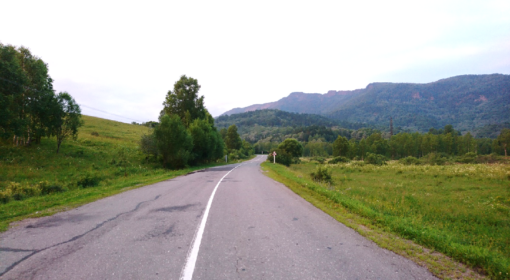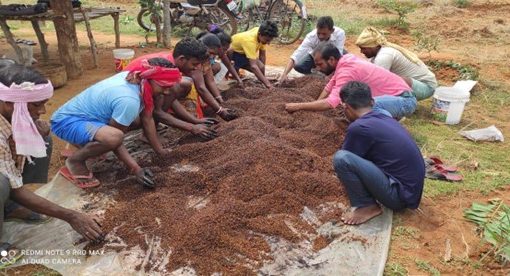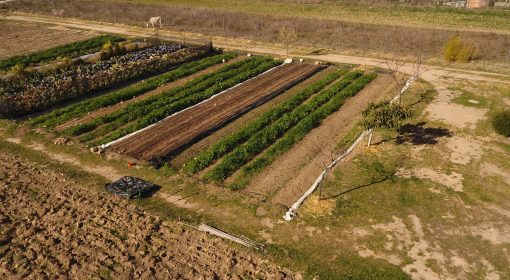By Rukiye Oca (MetaMeta Anatolia)
While mobility brings many goods, it also comes at a price. One such cost, often hidden from view, is the pollution of lands along the highways from vehicle exhausts.

As a country in development, the number of vehicles and traffic density are steeply increasing. While there were 8.655.170 motor vehicles in Turkey as of 2002, 23.153.556 vehicles in Turkey as of 2022 (TUIK 2022). Exhaust gases from vehicles have known toxic effects on humans, such as carbon monoxide (CO), unburned hydrocarbons (HC), Nitrogen oxide (NOX), Sulfur dioxide (SO2), Lead (Pb), and Carbon (C). Microplastic particles contain harmful waste. In addition, the use of poor quality fuel aggravates the damage. Several pollutants do not disintegrate. As a result, when we look at the process of this situation, which is harmful to humans, we can see that it is transferred to the living body with accumulation in the soil, plant, and water.
Heavy metals are critical pollutants: they have a toxic effect even at low concentrations. Heavy metal is defined by a physical density of metals over 5 gr/cm3. Over 60 heavy metals exist, such as chromium, iron, cobalt, lead, cadmium, copper, zinc, mercury, and nickel (Kahvecioğlu et al., 2007).
To examine the effect of the accumulation of vehicle exhaust gases in the soil, we selected cotton fields and pistachio fields on the sides of Şanlıurfa-Diyarbakır and Şanlıurfa-Akçakale roads. These two highways are among the busiest routes in Şanlıurfa. Soil samples were first taken from the Şanlıurfa-Diyarbakır highway. The samples were taken from two separate fields, on the right and left side of the road, at the 15 km exit of the city. The samples were taken at 0-2-15-40 m distance from the road, at 0-30 cm depth. This was repeated at 50 m intervals from 4 different distances, a total of 32 samples. Similarly, 32 samples were taken from the Şanlıurfa-Akçakale road on the outskirt of the city in the same way, using the same patterns. A total of 64 samples were taken at both sites.
Analyses were performed in the laboratory of Harran University. According to the results of soil analysis, lead (Pb), zinc (Zn), manganese (Mn), chlorine (Cl), chromium (Cr), cadmium (Cd), copper (Cu), nickel (Ni), sodium had accumulated due to exhaust gases. Although heavy metal concentrations such as sodium (Na) and iron (Fe) are lower than the allowable limit values in the sample area, lead (Pb), zinc (Zn), manganese (Mn), chlorine (Cl), chromium (Cr), cadmium (Cd), copper (Cu), nickel (Ni), sodium (Na) and iron (Fe) concentrations of heavy metals, such as the right and left of the highway was observed to decrease in direct proportion to the distance away from the road.
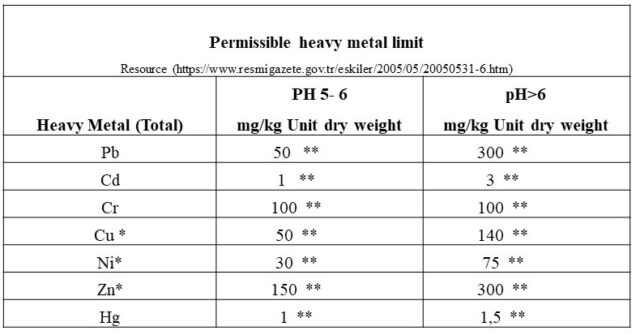
*If the pH value is greater than 7, the Ministry may increase the limit values up to 50% if it is not harmful to the environment and human health, especially to groundwater.
** In cases where it is proven by scientific studies that it is not harmful to the environment and human health in the areas where forage crops are grown, these limit values may be allowed to be exceeded.
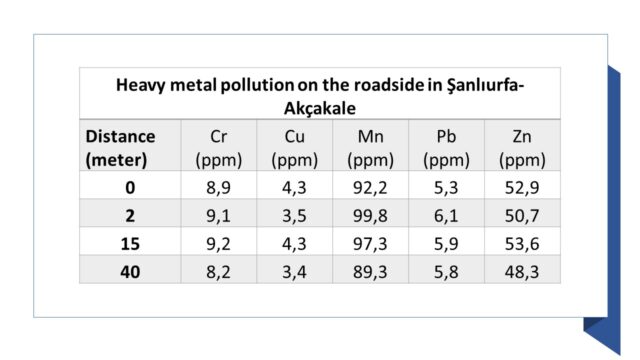
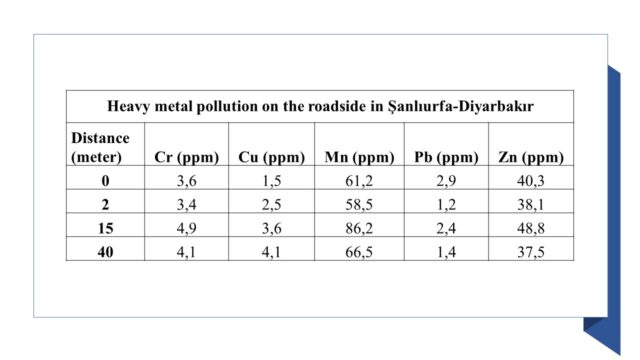
In the long term, this accumulation can reach severe damage. This toxic build-up of heavy metals can cause diseases such as Alzheimer’s, Parkinson’s, cancer, and liver failure in the human body.
Responsibility for this issue falls on public institutions and people. To leave a clean world for future generations, what is essential:
• Encouraging people to use public transportation
• Production and use of quality fuel should be improved
• Heavy metal accumulation and accumulation rate of the lands on the side of the highway should be determined by making necessary analyses.
• Pollution mapping of the region should be done with the determined data, and farmers should be directed to studies related to reducing pollution in these regions.
• We should promote the widespread cultivation of “accumulator plants” by road management authorities and farmers along the road.
WHAT CAN WE DO?
Expanding efforts to clean the areas exposed to pollution is necessary. Bioremediation, soil washing, cleaning in place, electrokinetic technology and mechanical separation methods and isolation immobilization technologies, accumulator plants (Thlaspi, Chenopodium, Urtica, Polygonum saccharase, and Alyssum), and some of the bacteria are methods used in heavy metal removal.
The easiest and most accessible method for road management authorities and farmers is to remove pollution with the help of accumulator plants and bacteria. Thaspi, Chenopodium, Urtica, polygonum, and alyssum are accumulator plants that can all contribute to soil remediation. Accumulator plants absorb heavy metals with the help of their roots. By removing these plants from the environment, we will ensure the removal of heavy metals.

Bacteria such as Alcaligenes faecalis, Bacillus pumilus, Pseudomonas aeruginosa, and Brevibacterium iodonium are highly resistant to mercury. They can grow at a concentration of 25 ppm or higher. They have also been observed to remove more than 70% of Cd and 98% of Pb.
Microorganisms can dissolve metals and reduce or oxidize transition metals. Different methods by which microbes restore the environment; oxidizing, binding, immobilizing, volatilizing, and transforming heavy metals. Bioremediation can be accomplished, especially with the designer microbe approach, and by understanding the mechanism that controls the growth and activity of microorganisms in contaminated areas, their metabolic capacities, and their response to environmental changes.
Bioremediation is based on microorganisms’ capacity to absorb pollutants and use them for their growth and metabolic activities. The primary purpose of bioremediation is to provide the most suitable conditions for microbial growth and activity. Different technologies can be used depending on the aeration and saturation degree of the area. Bioremediation is applied in two ways. First, by transferring nutrients to the place where the wastes are spilled, the bacteria already in the soil are activated according to the bacterial composition of the soil. This method is used at low pollutant concentrations. Second, the soil is excavated, and new bacteria capable of degrading pollutants are added. Environmental conditions are controlled or changed to optimize the metabolic activities and growth of microorganisms. In optimizing ecological conditions for bioremediation, factors such as temperature, inorganic nutrients (primarily nitrogen and phosphorus), electron acceptors (oxygen, nitrate, and sulfate), and pH are optimized.
When we look at the studies carried out in Turkey, we see that awareness is slowly building up. Still, steps have yet to be taken to address this situation or reduce the source of pollution. By implementing bioremediation solutions, we can contribute to reducing the accumulation of heavy metals on agricultural lands and protecting human health. Both government institutions and individuals must take responsibility to leave a clean world for future generations.


References:
De J, Ramaiah N and Vardanyan L (2008). Detoxification of toxic heavy metals by marine bacteria highly resistant to mercury. Marine Biotechnology, 10(4): 471-477
KAHVECİOĞLU Ö, KARTAL, G. GÜVEN, A, TİMUR, S.(2007) Environmental Effects of Metals –I.
(access address: www.metalurji.org.tr/dergi/dergi136/d136_4753.pdf)
Seven, T., Büşra, C. A. N., Darende, B. N., & Sevda, O. C. A. K. (2018). Heavy metal pollution in air and soil. National Journal of Environmental Science Research, 1(2), 91-103.
TUIK 2019, Number of motor vehicles by year, https://data.tuik.gov.tr/Bulten/Index?p=Motorlu-Kara-Tasitlari-Ekim-2019-30639#:~:text=Tablo%2D3-,Y%C4%B1llara,-g%C3%B6re%20motorlu%20kara
